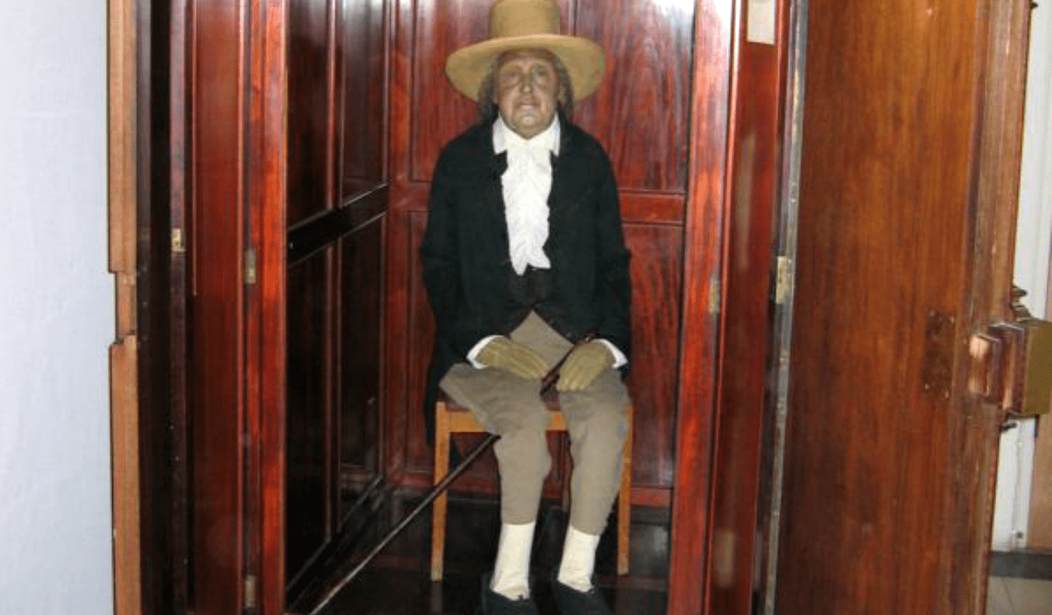Jeremy Bentham, an English philosopher and founder of Utilitarianism, passed away in 1832. His skeleton, fleshed out with wax and stuffing, traveled to New York City for display this week.
An atheist who prioritized the “greatest good for the greatest number,” Bentham dedicated his body to science after his death. In an era of grave-robbing for medical dissection, he willed that his corpse would be dissected — and then stuffed to be preserved for future generations. His skeleton has been on display at University College London (UCL) ever since, but now he has taken a trip across the pond to the Met Breuer museum in New York.
Bentham always wanted to visit America, but he never got the opportunity to do so in life. Before the journey, however, his artificial body had to be disrobed and restructured to make sure he was not infested with bugs.
“The first thing we had to do was to discover whether he was suffering from any infestations,” Jayne Dunn, head of Collections Management at UCL, told Britain’s The Telegraph. “We don’t want to send an object to another museum and infect their collection with pests. If he had been we would have had to fumigate him.”
Why is the bug test necessary? “He is wearing the original underwear — which has not got infested — and two sets of stockings, one over the other,” Dunn explained. “Carpet beetles love wool but they are less keen on linen which is why we think the vest, underpants and stockings have survived.”
Padded with wood shavings and held in place by a large stocking over the body, the philosopher’s body is not unlike an old couch which needed to be upholstered.
“When you have an old sofa everything settles into the bottom and you have to plump up the cushions,” Subhadra Das, a UCL curator, told The Telegraph. “Well, the same thing happened with Bentham. We have not added anything but reapportioned where it is so he looks a lot slimmer.”
In his will, Bentham instructed his friend Southwood Smith to place his skeleton on display. He asked that his remains “be put together in such a manner as that the whole figure may be seated in a chair usually occupied by me when living, in the attitude in which I am sitting when engaged in thought.”
Every part of the fabricated body is connected to the real skeleton — except the head. That separate artifact is on temporary display at UCL. After Bentham’s death, Smith preserved the head using techniques adopted from the Māori in New Zealand, adding a bit of sulphuric acid. This experiment largely failed, leaving the philosopher’s face red, and the skin taut and leathery.
The head went on display for the first time in decades, in the exhibit “What Does It Mean To Be Human? Curating Heads at UCL.” The exhibition also includes the head of archaeologist Flinders Petrie, who donated his body to science on his death in 1942.
The body has joined the New York exhibition “Life Like: Sculpture, Color and the Body.” This exhibit documents 700 years of sculpture from 14th century Europe to the present, including such artists as Donatello, El Greco, Auguste Rodin, and Edgar Degas.
Bentham’s Utilitarian philosophy centered on a “fundamental axiom” that “it is the greatest happiness of the greatest number that is the measure of right and wrong.” This view led him to advocate political positions that were radical for his day, such as individual and economic freedoms, the separation of church and state, free speech, equal rights for women, the decriminalizing of homosexuality, and the abolition of slavery, the death penalty, and physical punishment.
Bentham helped to create the Thames River Police, and he advocated for a “Panopticon” for guards to supervise prisons.
Bentham corresponded with many notable thinkers of his day, including the economist Adam Smith and leaders of the French Revolution. He was declared an honorary citizen of France, but he attacked the revolutionary presentation of natural rights and the violence under Jacobin rule (starting 1792).
Tellingly, this atheist opposed the philosophy of Natural Law, which undergirded the American Declaration of Independence and the Constitution, and he actually wrote an essay attacking the Declaration in 1776.
Moderns hail Bentham as a man “ahead of his time,” but in reality his ideas likely inspired many political and social movements, for good or ill. His secular Utilitarianism does seem to dominate most political discussions, and the fact that he attacked the Declaration of Independence should make Americans hesitant to champion his ideas.
All the same, Bentham definitely deserves to be remembered, and the gruesome details of his remains actually tell a good part of his story. The man believed his Utilitarianism so forcefully that he would give his body to public service — through dissection and through display. Whatever else could be said of him, this philosopher definitely bought what he was selling.









Join the conversation as a VIP Member